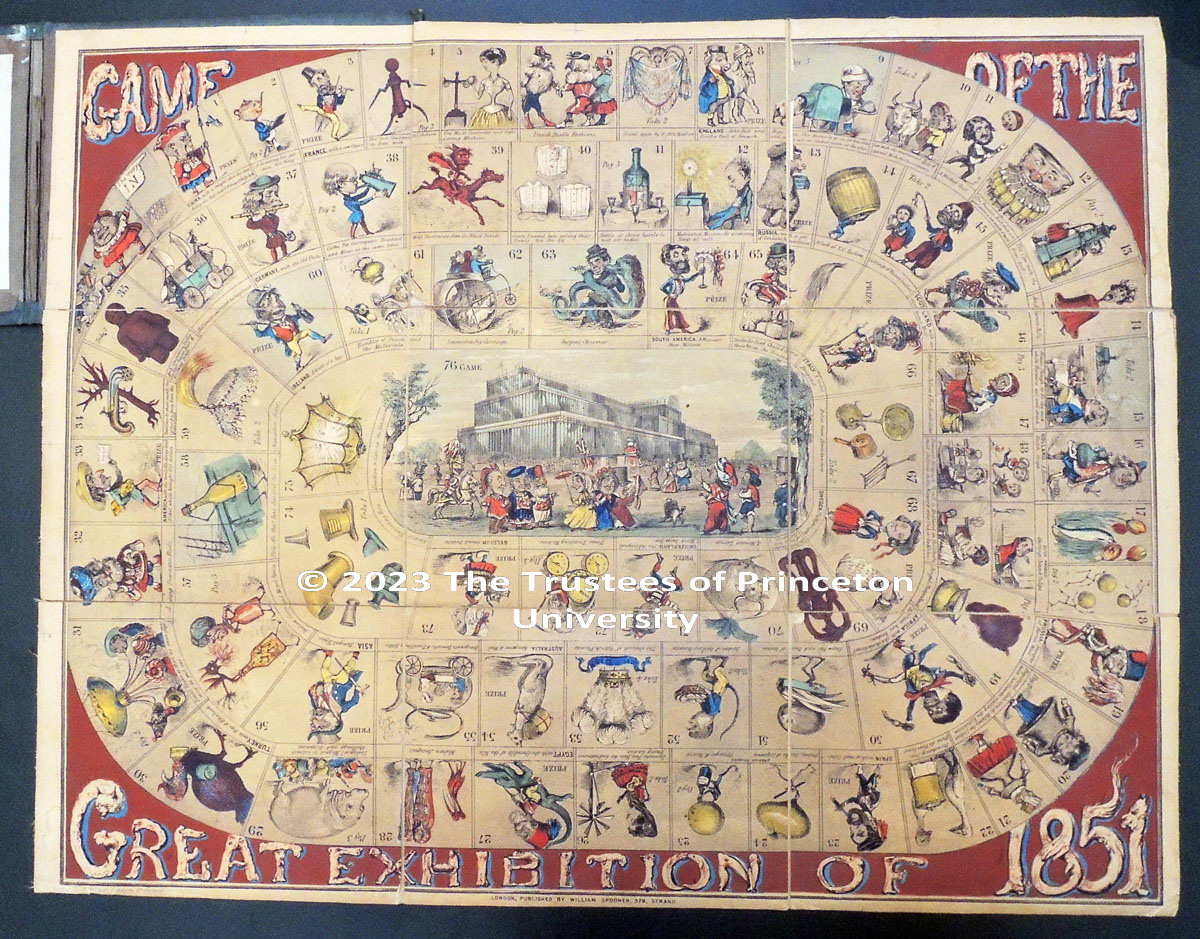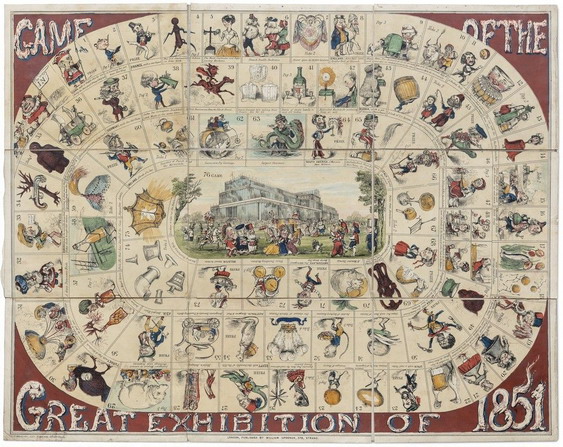Giochi dell'Oca e di percorso
(by Luigi Ciompi & Adrian Seville)
(by Luigi Ciompi & Adrian Seville)

|
Giochi dell'Oca e di percorso
(by Luigi Ciompi & Adrian Seville) |

|
 |

Torna alla ricerca giochi (back to game search) |
 |
| Comic Game of the Great Exhibition of 1851 | ||
 |
Versione stampabile
 |
Invia una segnalazione

|
  |
primo autore: | Anonimo |
| secondo autore: | Spooner William | |
| anno: | 1851 | |
| luogo: |
Inghilterra-Londra |
|
| periodo: | XIX secolo (3°/4) | |
| percorso: | Percorso di 76 caselle numerate | |
| materiale: | carta incollata su tela (engraving on paper with linen backing) | |
| dimensioni: | 500X640 | |
| stampa: | Litografia colorata (hand-colored lithograph) | |
| luogo acquisto: | ||
| data acquisto: | ||
| dimensioni confezione: | 220X180 | |
| numero caselle: | 76 | |
| categoria: | Agricoltura, Industria, Commercio, Esposizioni, Arti e Mestieri | |
| tipo di gioco: | Gioco di percorso | |
| editore: | Published by William Spooner, 379 Strand | |
| stampatore: | Non indicato | |
| proprietario: | © 2023 The Trustees of Princeton University | |
| autore delle foto: | © 2023 The Trustees of Princeton University | |
| numero di catalogo: | 2832 | |
| descrizione: |
Gioco di 76 caselle numerate, spirale, orario, centripeto. Al centro, casella 76, il Crystal Palace sede dell'esposizione. Si gioca con un teetotum. REGOLE: allegate e nelle caselle. CASELLE: con didascalia. REFERENZA 1 "This game illustrated objects included in or views of the exhibition at the Crystal Palace. The game was played with a teetotum with the goal of landing on N°76: The External View of the Crystal Palace of the Exhibition." (Liman). The game board includes caricatured figures representing countries from around the world, a number of which are portrayed with racial stereotypes. (Yale Center for British Art) REFERENZA 2 The Graphic Arts Collection recently acquired this unabashedly politically incorrect board game, in which people from around the world meet in London at the 1851 Great Exhibition. Caricatures of all races, creeds, and occupations are encountered as players make their way around this ‘game of the goose’ published by William Spooner. For some reason, this game has 76 squares rather than the typical 63. The central winning square is the Crystal Palace itself with international visitors mingling outside the building. (Princeton University) REFERENZA 3 The Crystal Palace If you took an omnibus along London's Knightsbridge in the summer of 1851, you would see an astonishing sight. Glittering among the trees was a palace made of glass, like something out of the Arabian Nights. It was as tall as the trees, indeed taller, because the building arched over two of them already growing there, as if, like giant plants in a glasshouse, they had been transplanted with no disturbance to their roots. A shower of rain washed the dust from the glass, and made it glitter all the more. Nothing like this had been seen in London, ever. It was the Great Exhibition of the Works of Industry of All Nations. The Great Exhibition was the brain-child of Queen Victoria's husband, Prince Albert. Britain was at peace. The Chartists had meekly delivered their Petition to the House of Commons in three cabs, and gone home. Albert could write to his cousin King William of Prussia, that ‘we have no fear here either of an uprising or an assassination. England was experiencing a manufacturing boom. This was the time to show off, on the international stage. (Liza Picard, "The Great Exhibition".) Exhibitions: |
|
| bibliografia: |
1) WHITEHAUSE, F.R.B.: "Table Games of Georgian and Victorian Days", London, Peter Garnett, 1951. 2) GOODFELLOW, Caroline: "A Collector's Guide to Games and Puzzles". Secaucus, New Jersey, Chartwell Books-London, Quintet Publishing Limited 1991. 3) GOODFELLOW, Caroline: "The Development of the English Board Game, 1770-1850", in Board Games Studies 1, 1998. 4) GOODFELLOW, Caroline: "Jeux de société. Le guide du collectionneur des jeux de société depuis le XVIIIe siècle jusqu’à nos jours", (Edizione francese) Carrousel MS, 2001. 5) SEVILLE, Adrian: "The Game of Goose: and its influence on cartographical race games" Journal of the International Map Collectors' Society, Winter 2008 N°115 2008. 6) SEVILLE, Adrian: "The geographical Jeux de l'Oie of Europe." In "Belgeo" 2008 3-4 2008. 7) GOODFELLOW, Caroline: "How We Played: Games From Childhood Past", History Press, 2012. 8) QUINN, Brian - CARTWRIGHT, William: "Geographic Board Games". Geospatial Science Research 3. School of Mathematical and Geospatial Science, RMIT University, Australia. December 2014. 9) SEVILLE, Adrian: "The Royal Game of the Goose four hundred years of printed Board Games". Catalogue of an Exhibition at the Grolier Club, February 23 - May 14, 2016. 10) LIMAN, Ellen: "Georgian and Victorian Board Games: The Liman Collection", Pointed Leaf Press, 2017. 11) NORCIA, Megan A.: "Gaming Empire in Children's British Board Games, 1836-1860". Studies in Childhood, 1700 to the Present. Routledge, 2019. |
|
| "The Development of the English Board Game", 1770-1850 (Caroline G. Goodfellow) | ||
| Instructional Games. "Table Games of Georgian and Victorian Days". (Francis Reginald Beaman, Whitehause) | ||
Vai alla ricerca giochi Vai all'elenco autori